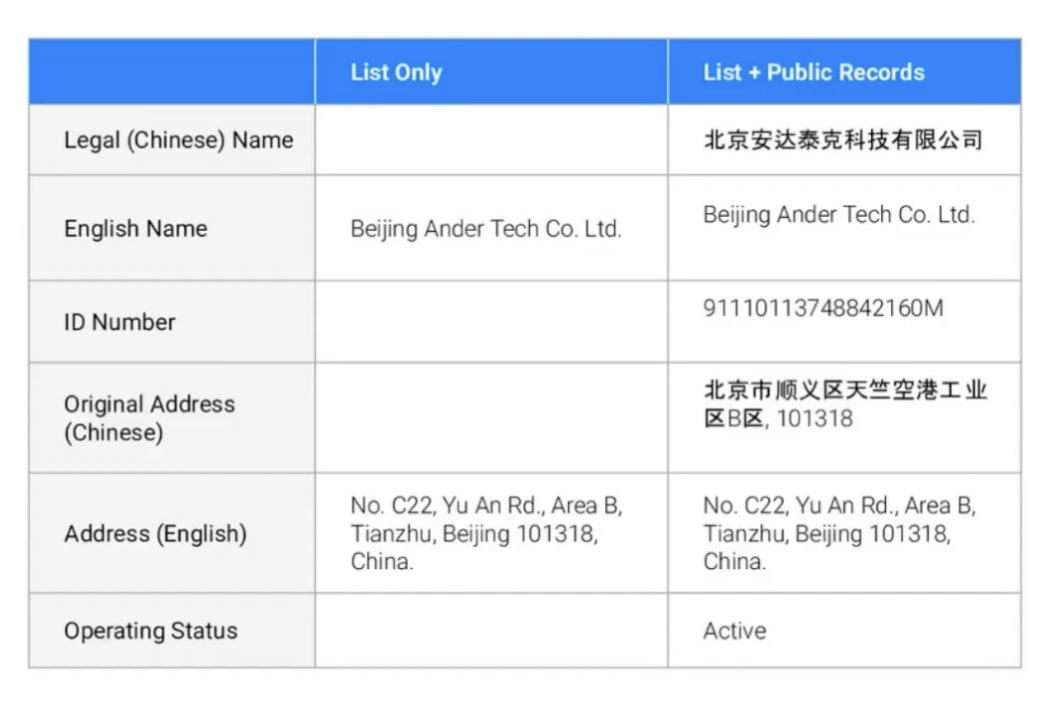The U.S. government has made it clear that businesses affiliated with the Chinese military are a threat to national security, but finding those military ties can pose a slew of challenges. Through public records coupled with a basic understanding of China’s Military Civil-Fusion (MCF) policies, investigators can get ahead of these issues and uncover hidden risks.
In our latest Master Class, our team of analysts created a framework of key questions to ask when investigating if an entity has potential ties to the Chinese military. This framework applies to both industry investigators seeking to more effectively mitigate supply chain risks and government analysts looking to identify and better understand Chinese military-affiliated companies.
Question 1: Is the company on a watchlist?
The first step is to cross-reference a selected entity with current watchlists. While it may seem like an obvious first step, it can be challenging to tell what companies are actually on each list.
The lists that the U.S. government maintains on Chinese military-affiliated companies include the Military End User List, published by the Department of Commerce; the Section 1260H List, published by the Department of Defense; executive orders 13959 and 14032; and the Non-SDN Chinese Military Industrial Complex Companies (NS-CMIC) List, published by the Department of the Treasury.
Each U.S. watchlist features, at a minimum, the English version of Chinese company names. But starting solely with the English name of a Chinese company can pose issues. In mainland China, company names in Chinese are highly standardized (and unique), but their English trade names can vary, and sometimes the name they’re known by in the West doesn’t appear in Chinese public records. . Therefore, investigators should use public records to enrich government watchlists with the level of detail needed to fully proceed with an investigation.

Question 2: Is the company owned by a company on a watchlist?
Sometimes risk can be hidden through multiple layers.Therefore,it’s important to look at corporate relationships when assessing whether or not a company may be at high risk of supporting the Chinese military via MCF. A company of interest that is owned or controlled, directly or indirectly, by another company that appears on one of these U.S. watchlists poses a higher risk of Chinese military affiliation.
With Sayari Graph’s explore feature, users can quickly visualize beneficial ownership to see if there are ties in the ownership structure to watchlisted companies. This is particularly important because Chinese corporate networks can be quite extensive. In the Master Class, our analysts highlighted a case where a watchlisted company owned nearly 70 separate companies, none of which individually appeared on a watchlist.
Question 3: Does the company have investment from MCF funds?
To mitigate risk beyond the watchlists, our team recommends paying attention to Chinese Military-Civil Fusion (MCF) investment funds. These funds are explicitly directed towards military-civil fusion and dual-use goods– and therefore the companies receiving investments from these funds are at a higher risk of supporting the Chinese military, despite not appearing on a watchlist.
Question 4: Is the company located in the MCF innovation zone?
Another way China has incentivized participation in military-civil fusion is through MCF innovation zones. These are generally office parks that provide space and capital for companies producing dual-use technologies. If a company is based out of one of these zones now – or was at some point in the past – it’s likely that the Chinese government has their eyes on that company’s products and technology for adaptation to military uses.
For more details on strategies for finding hidden ties to Chinese military companies, and to see these strategies in practice, watch our Master Class, “Uncovering Chinese Military Companies.” The class also features an in-depth tutorial on how to conduct these deep investigations efficiently in Sayari Graph.